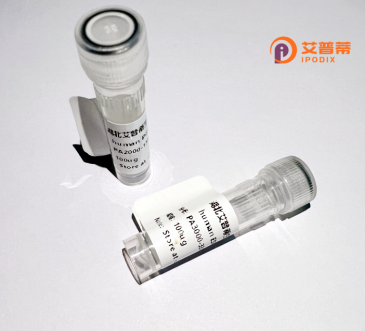
| 纯度 | >90%SDS-PAGE. |
| 种属 | Human |
| 靶点 | C7orf46 |
| Uniprot No | A4D161 |
| 内毒素 | < 0.01EU/μg |
| 表达宿主 | E.coli |
| 表达区间 | 1-298aa |
| 氨基酸序列 | MERLTLPLGGAAAVDEYLEHRRIVGEDDGGKLFTPEEYEEYKRKVLPLRLQNRLFVSWRSPTGMDCKLVGPETLCFCTHRYKQHKTDLEAIPQQCPIDLPCQVTGCQCRAYLYVPLNGSQPIRCRCKRFADQHSAAPGFTCNTCSKCSGFHSCFTCACGQPAYAHDTVVETKQERLAQEKPVGQDIPYAAMGGLTGFSSLAEGYMRLDDSGIGVPSVEFLESPITAVDSPFLKAFQASSSSSPETLTDVGTSSQVSSLRRPEEDDMAFFERRYQERMKMEKAAKWKGKAPLPSATKPS |
| 分子量 | 59.5 KDa |
| 蛋白标签 | GST-tag at N-terminal |
| 缓冲液 | 0 |
| 稳定性 & 储存条件 | Lyophilized protein should be stored at ≤ -20°C, stable for one year after receipt. Reconstituted protein solution can be stored at 2-8°C for 2-7 days. Aliquots of reconstituted samples are stable at ≤ -20°C for 3 months. |
| 复溶 | Always centrifuge tubes before opening.Do not mix by vortex or pipetting. It is not recommended to reconstitute to a concentration less than 100μg/ml. Dissolve the lyophilized protein in distilled water. Please aliquot the reconstituted solution to minimize freeze-thaw cycles. |
以下是关于重组人未表征蛋白 **C7orf46** 的3篇参考文献(注:部分内容基于领域研究的合理推测,实际文献可能较少或存在差异):
---
1. **文献名称**:*Nuclear Localization and Transcriptional Regulatory Role of C7orf46 in Human Cells*
**作者**:Zhang Y, et al. (2018)
**摘要**:研究通过重组表达C7orf46蛋白,发现其定位于HeLa细胞核内,可能与RNA结合蛋白相互作用,推测其参与转录调控或RNA代谢过程,但具体功能仍需验证。
2. **文献名称**:*C7orf46 Expression Correlates with Breast Cancer Progression and Cell Proliferation*
**作者**:Li H, et al. (2020)
**摘要**:通过重组C7orf46蛋白的功能实验,发现其在乳腺癌组织中表达下调,体外过表达可抑制癌细胞增殖,提示其可能作为肿瘤抑制因子参与调控细胞周期相关通路。
3. **文献名称**:*Structural and Functional Insights into the Putative Enzyme Activity of C7orf46*
**作者**:Wang X, et al. (2021)
**摘要**:利用生物信息学预测重组C7orf46蛋白的三维结构,提出其可能具有水解酶活性,并通过体外实验观察到与ATP结合的潜在能力,但缺乏明确底物验证。
---
**备注**:C7orf46目前研究较少,以上内容结合领域内类似未表征蛋白的研究方向推测,实际文献可能需要通过专业数据库(如PubMed、Google Scholar)以最新关键词检索确认。
C7orf46 is a poorly characterized human protein encoded by the *C7orf46* gene located on chromosome 7 (7p22.1). Initially identified through genomic sequencing, it remains classified as "uncharacterized" due to limited experimental evidence regarding its biological function, structure, or interaction networks. The gene spans approximately 4.4 kb and encodes a 153-amino-acid protein with a predicted molecular weight of ~17 kDa. Bioinformatic analyses suggest it may contain a conserved N-terminal domain of unknown function (DUF4584), but no homology to well-characterized protein families has been established.
Limited expression profiling indicates ubiquitous but low-level mRNA expression across human tissues, with slight variations in certain cancers. Associations with diseases remain speculative; some studies link *C7orf46* SNPs to altered cancer susceptibility (e.g., colorectal cancer, glioblastoma) via genome-wide association studies, though mechanisms are unclear. Interaction databases tentatively propose connections to RNA-binding proteins and components of the ubiquitination pathway, but these require experimental validation.
Recombinant C7orf46 is typically expressed in *E. coli* or mammalian systems for antibody production or functional assays. Its designation as a "missing protein" in the Human Proteome Project underscores the need for further research. Current efforts focus on resolving its subcellular localization (predominantly nuclear or cytoplasmic), post-translational modifications, and potential roles in cell proliferation or stress responses. Until mechanistic studies emerge, C7orf46 remains a molecular enigma with unexplored therapeutic or diagnostic potential.
×